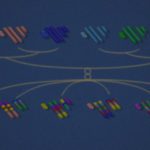Link to Pubmed [PMID] – 19490077
Evolution 2009 Oct;63(10):2668-86
To assess the genetic basis of the skull shape variation and morphological integration in mice, we have used a tool based on the cross between the distantly related mouse species Mus spretus (SEG/Pas strain) and the laboratory strain C57BL/6 called interspecific recombinant congenic strains (IRCSs). The genome of each IRCS consists on average of 1.3% of SEG/Pas derived sequences, located on multiple chromosomes as small-sized, DNA segments. Quantitative trait loci (QTL) on the skull shape, separated into dorsal and ventral sides, were analyzed in 17 IRCSs by a Procrustes superimposition method using 3D landmarks. The shapes of 16 strains differed significantly from C57BL/6. Discrepancy in the QTLs effects was found between the dorsal side and the anterior region of the ventral side due to a differential effect of the SEG/Pas alleles on the skull shape. A comprehensive analysis of all allelic combinations of the BCG-66H strain showed strong epistatic interactions between SEG/Pas segment acting on both skull sides. Epistatic pleiotropy and covariation between sides were dependent in SEG/Pas alleles direction and contributed to the strong morphological integration between sides. Introduction of Mus spretus alleles in a C57BL/6 background induced strong morphological changes mostly in SEG/Pas alleles direction and provided evidence for high level of morphological integration.

